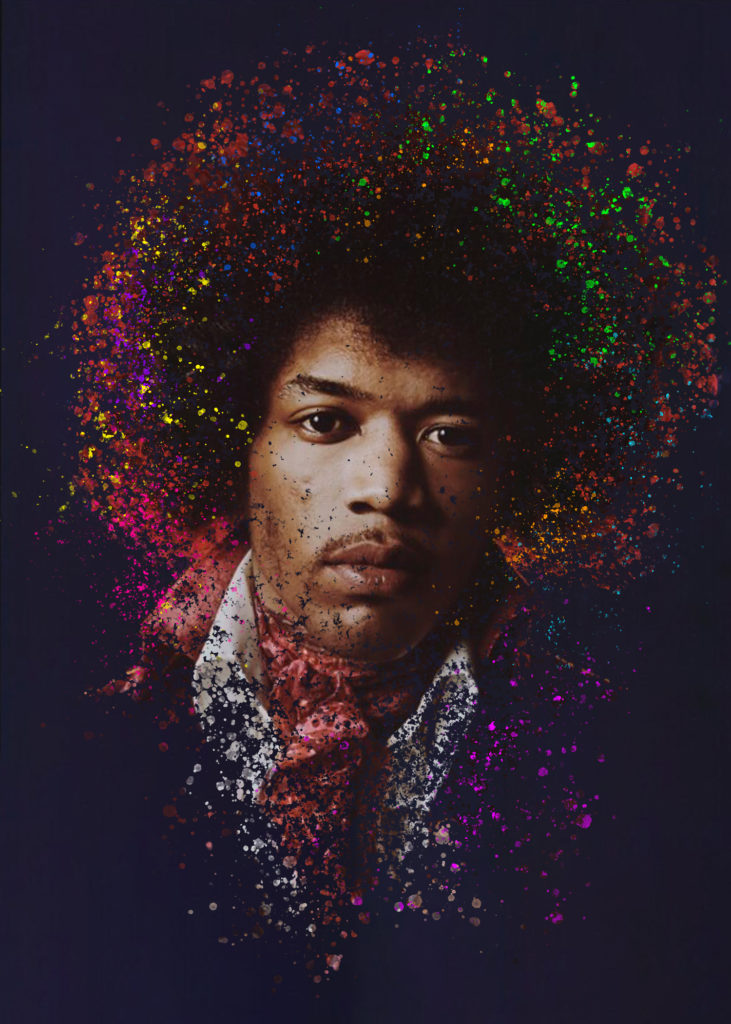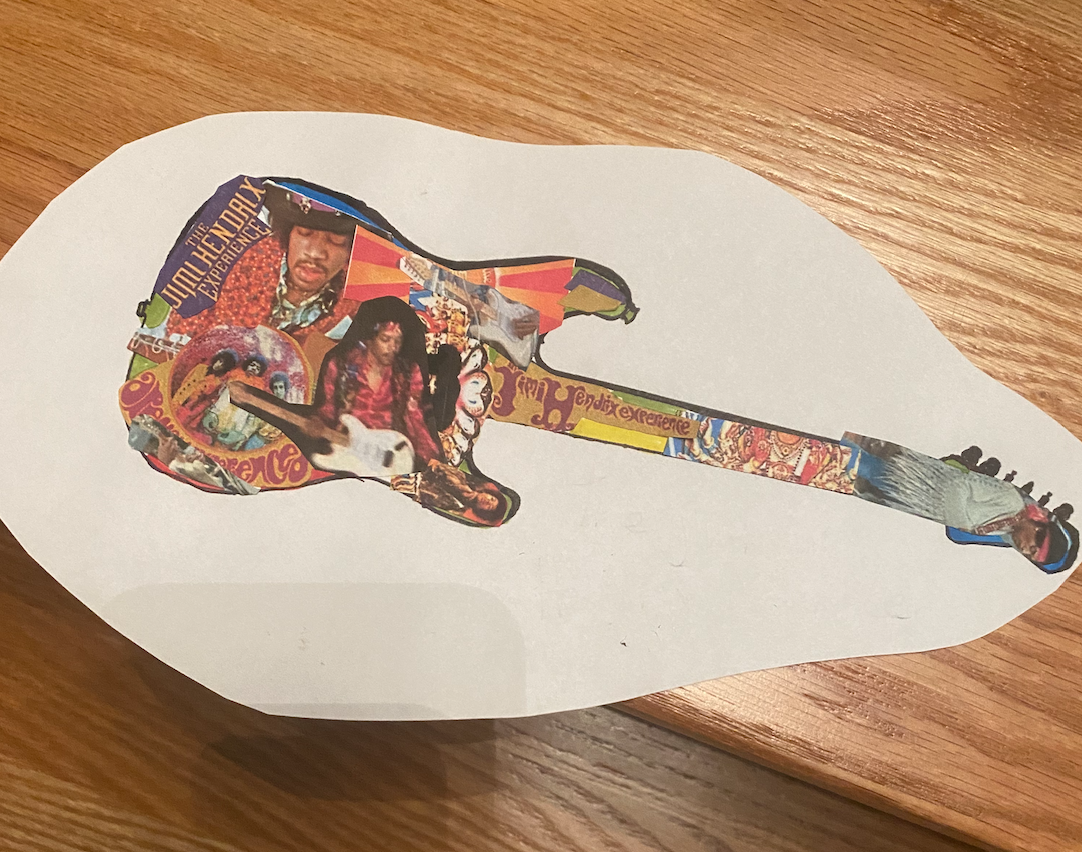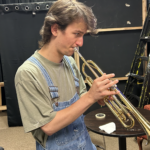The History and Popular Music of the ’60s class learned about Jimi Hendrix’s 1968 double LP. Here are their reactions.
Pritam Khalsa:
In 1968 Jimi Hendrix released his third album, Electric Ladyland. It was incredibly successful and reached number one on both Canadian and US charts. It contained 16 songs—one of which being a shorter version of an earlier song—and it lasted an hour and fifteen minutes. Many of the songs (especially the singles) were shorter, making them more radio friendly. The two singles were “Crosstown Traffic” and “All Along the Watchtower” which was originally a Bob Dylan song, however, Jimi Hendrix’s cover is the more widely known version. Hendrix was a huge fan of Dylan and would listen to his music and make others around him listen as well. Despite Dylan only being a year older, he appeared to be a major influence to Hendrix and his career. He also played one of Dylan’s most famous songs, “Like A Rolling Stone”, at the Monterey Pop Festival in 1967. Despite their different styles and seemingly different personalities, Hendrix and Dylan are more similar than they appear. They both defined their genres and helped set the stage for future artists at a young age. Neither of them seemed to enjoy answering questions about themselves or going to interviews, although Dylan appeared more annoyed by them while Hendrix looked slightly anxious and uncomfortable. Although Hendrix only got to release three records before he passed away in 1970, he is still considered one of the greatest guitar players. His incredible stage presence and love of playing guitar made him a better artist.
Alex Skiles:
I took a colorized photo of him, warped it and applied a paint splotch effect with a brush in photoshop, as well as a few other paint splotches for effect. I wanted his afro to look like one big paint splotch, with little paint explosions of creativity/sound around his head. This is my first time using an effect like this, and it was fun to learn.
Sam Swartley:
I decided to go more in depth on the tune “1983…(A Merman I Should Turn to Be). This song is a real trip and I love it.
The song opens with a spirally, psychedelic, dreamy guitar white noise. Then setting up the tune is the cleanest plucking classic rock line that builds up into an anthem like lead line. This line recurs across the whole tune in a way that everyone will know by heart after listening to the whole track.
Hendrix’s lyrics come in at the cleanest time. His lyrics give this feeling of hope and describe the idea of immortality and “forever,” while also hinting at this idea of controversy within the world. His guitar backing these droning vocals have a hint of soul with the strength of heavy metal.
As we go into the second verse Hendrix goes more in depth on this idea of war and fighting, pretty much implying that the world isn’t a totally perfect place. Between each verse Hendrix hits us with the same straight ahead anthem lead guitar line.
Starting the third verse with one of the most powerful lines: “Well, it’s too bad, that our friends can’t be with us today.” This line really stands out to me, to me I believe that Jimi is saying that we have to move on from our friends (you let them go, or they pass away) and/or our friends don’t got what “we” got. Whether this is what Jimi meant or not that’s how I interpreted it. Throughout this verse there is this arpeggiating line that really hits the spot for me, it really pushes the song forward and makes this verse really stand out. Another line in this verse is “The machine we built will never save us.” I interpreted the “machine” as the world/society that in a way we as humans created and that the only thing that will “save us” is ourselves. What does saving us look like? Well, in my mind it’s facing your fears, taking on the world with open arms and finding pear joy. Later in the verse Jimi sings, “it’s impossible for a man to live and breath underwater forever,” this is implying that you can’t just push feelings and emotions away, you gotta take it straight on, face your fears.
The arpeggio line really takes off moving the tune in a totally different direction. Ending with a bang on a few happy/edgy chords, with the drums loosely holding them together. The drums then lead us into a very unique dreamy verse four.
Verse four starts in an almost depressing manner, in my mind a look at the last moments of life, or a true life. Making love to “salute the last moment ever on dry land.” This one: shows how much Jimi values the importance of sex, and two: relates back to the line about “drowning.” This last moment on dry land in this case is the last moment before the machine engulfs whoever is in this moment. The last line of this verse is the strongest for me: “At the killing noise of the out of style.” This line shows the importance of change, and constantly changing. If we don’t everything will therefore be “out of style.” In a way it’s the artist’s responsibility to move on and not always do what the audience wants. Things go out of style for (real) artists, and (real) creators quickly. Why play the same thing at every show seven days a week? Why not discover new emotions within the world? This is what I love about music and the creation of art, there’s no end, it answers the questions we can’t even imagine.
Jimi once again hits us with the anthem lead line. And then we go into a more free form jam, with lots of different layers of sound and rhythm creating this dreamy landscape of time and emotion. In a way it’s almost scary. It puts this image of a desert wasteland, and on top of a windy mountain, looking over this wasteland, is Hendrix fully immersed in his guitar, his sound. Hendrix starts playing more melodically, while still keeping the free time feel, layering the bass player on top of that. You can even hear a flute type sound on top of these disconcerting sounds. When the guitar starts to play a more rhythmic riff, every other sound starts to go crazy pushing the limits of sound and music. In my mind all of these sounds and rhythm changes move you to a head space of new emotions you’ve never felt before. A trip. This bass line that comes in might be my favorite melodic idea that happened over the course of the entire album. It really takes you away. As the bass player adds delay and more tension between everything the rest of the band really starts rolling. You get these intense spacy sounds mixed with Jimi’s intense guitar that is beautiful in an unhuman way.
Then everything chills out… into a very long easy drum fill that bursts us back into Jimi’s final verse. Which I can’t lie doesn’t make a whole lot of sense. Besides that fact that he wants to be a mermaid. In my mind implying that he can live and breathe underwater forever, implying that nothing in the world could take him down. The water is the fear and evil in the world, Jimi Hendrix wanted to swim down so deep and enjoy it all, as a mermaid (?).
My interpretation of his vocals and the vibe of the whole jam. Really dig this tune, it really takes me somewhere.
Lily Brooks:
I drew one of Jimi’s guitars and had the background be the colors of the album cover. I tried to make it vibrant to show the vibe of the album. All of the background lines extend from the guitar to show how that’s the star of the show.
Gibson McCoy:
Something that I never knew about Jimi Hendrix was that offstage he was very self-conscious and shy. Looking at some of his performances you would never be able to tell unless you talked to his friends or watched an interview. He does not like getting compliments, he thinks they are awkward and they make him uncomfortable. His stage presence and the show that he puts on at a concert are very different from how his friends describe how he acts. For example, if you looked at his performance at Monterey Pop you see a guy that wears crazy clothes, is confident and probably has a big ego. Everyone knows that Jimi Hendrix was a revolutionary guitar player so for my AR I decided to put his stage presence in his guitar to show that without his guitar Jimi and his stage presence wouldn’t be the same. There are cut-up pictures of him performing on stage to represent how his guitar and an audience make his stage presence shine. He truly becomes a different person than the one that the press sees when they talk to him off stage and without a guitar.
Conor McGeady:
Electric Ladyland is an odd but very interesting and musically challenging record, and was revolutionary for its time due to the focus on atmosphere over concept. To the sci-fi-esque opening track with droning noise to the guitars drenched with reverb and distortion, this album is truly unique. I feel that with other genres in the 6’0s, there were comparisons between artists of similar genres, such as the Beatles vs. the Rolling Stones or Beach Boys vs. the Zombies, but I honestly don’t have any other group similar to the Jimi Hendrix Experience to even compare them to. To put it more simply, I’ve never heard anything quite like this before.
When it comes to pure talent on a guitar, Jimi Hendrix is most definitely up there with legends such as Eric Clapton or Eddie Van Halen, and the case could be made for him even surpassing them in skill on the guitar. Due to the amount of distortion, reverb, flangers and other effects on the guitars, there’s so much variety so the sound of the guitar while maintaining the same level of instrumentation from Jimi Hendrix. Whether you’re a fan of rock and roll, jazz, funk, soul or metal, the guitars on this record are bound to impress you.
On top of the sheer talent on the guitar, the atmosphere it creates is also incredibly important to the album. The Jimi Hendrix Experience do a fantastic job at blending their instruments together enough to give a solid sense of musical consistency, but also keep their parts loose enough to allow for micro improvisations. They allow each instrument to be heard and have their spotlight at times, but then easily pull your attention right back to the meat of the record, which is of course Jimi Hendrix’s vocals and guitar.








Leave a Reply